405 bridge work causes a stink
July 24, 2014
The bridge that brought you Carmageddon is back in the spotlight this weekend—in a decidedly less dramatic role.
The Mulholland Bridge over the 405 Freeway will be closing on Friday and Saturday nights so that workers can seal the surface with a substance called methacrylate. The work is needed to coat “very small cracks” that have developed on the bridge surface. Methacrylate is a common though sometimes odiferous treatment for concrete decks.
“These aren’t structural defect cracks,” said Mike Barbour, who is Metro’s lead on the $1-billion-plus 405 Project, which is now virtually complete and is in its final “punch list” stage. Rather, he said, they are the kind of tiny cracks that can emerge when “the surface dried out too soon.”
The bridge will be closing from 10 p.m. Friday till 8 a.m. Saturday, with the pattern repeating on Saturday night through Sunday morning.
Beyond the detours, there’s this side effect: “An unpleasant odor may arise from this treatment,” according to a construction notice advisory sent out this week.
Few residents are likely to be troubled by the smell, however, Barbour said.
“There’s nobody really close by,” he said. “I seriously doubt that it’ll affect anyone.”
The Mulholland Bridge sparked a global media sensation in two Carmageddons during which it was demolished and completely rebuilt. The bridge work came as part of an ambitious effort to improve numerous elements of the 405 through the Sepulveda Pass while adding a 10-mile northbound carpool lane. The new lane opened in May.
Posted 7/24/14
Not just a drop in the bucket
July 9, 2014
When it comes to quenching the water needs of a thirsty region, seemingly modest or far-flung efforts can come together to make quite a splash.
Witness a dozen local projects, from Agoura Hills to south Gardena, that just received an infusion of state grant funding totaling $23.4 million. Each initiative has a singular focus—creating bigger and better groundwater supplies in Pacoima, for instance, or installing curb screens in Calabasas to keep debris from flowing from city streets to the ocean.
But collectively, these endeavors add up to something greater than the sum of their parts: an integrated approach as diverse agencies come together to advance the kinds of water projects that will do the most good across the region.
As California’s drought makes headlines and prompts consideration of mandatory conservation measures, several of the projects have an extremely timely aim: retaining as much stormwater as possible to boost the region’s drinking water supply. Others focus on improving water quality, while some combine water initiatives with community recreation and beautification efforts.
Together, they’re the wave of the future, as the Los Angeles region looks beyond its Mulholland-era history and imagines a new approach to the next 100 years.
“It’s a new paradigm, a paradigm of cooperation and collaboration,” said Mark Pestrella, chief deputy director of the county’s Department of Public Works, which is overseeing the grant projects as leader of the Integrated Regional Water Management coalition in greater Los Angeles.
“There are 500 small water agencies in L.A. County alone, and probably six major water agencies, all talking to each other, reaching out to the communities that we serve and identifying projects that have the biggest community benefit,” Pestrella said.
The $23.4 million in Prop. 84 grant funding that was formally accepted by the Board of Supervisors this week is just one such infusion over the past decade. Since the collaborative water management model went into effect in California in 2002, nearly $100 million has been awarded to water resource agencies in the county, Public Works Director Gail Farber said. The state grant funds, she added, “go a long way towards ensuring a more sustainable water future for L.A. County.”
The endeavors awarded the grant funds approved this week include:
- The Pacoima Spreading Grounds Improvement Project, where new and updated equipment and improved stormwater storage will yield enough new drinking water to supply 42,000 Los Angeles residents for a year. Plans also are under consideration to create a park or open space on the grounds of an adjacent channel.
- Development of a second phase of Marsh Park in the Elysian Valley neighborhood near the L.A. River. The new design will convert industrial land into an open space park that also happens to collect and treat stormwater.
- Restoration of a 34-acre “flood retention basin” in the Upper Malibu Creek Watershed area.
- Design and construction of a 1¼-mile recycled water pipeline in south Gardena.
And, with California’s drought front and center, more help may be on the way soon. The state later this month is expected to issue a new round of grant funding devoted exclusively to drought-fighting projects.
An ambitious slate of 14 L.A. County projects seeking more than $28.8 million in funding has been submitted, with an emphasis on water recycling and replenishing groundwater. The overall goal of the drought-related projects is building the local water supply and reducing dependence on imports.
Posted 7/9/14
Heroes in hardhats
January 8, 2014
They have rescued small children from oncoming traffic. They have brought a victim of attempted murder back from the brink of death. They have braved rising floodwaters and raging house fires. Last month, they dragged an unconscious driver from a burning SUV seconds before the truck’s gas tank exploded.
Not all first responders are sheriff’s deputies or firefighters. Some also find themselves in the occasional life-and-death situation while minding the county’s infrastructure at the Department of Public Works.
Emergency response has been among DPW’s core services since 1985 when the department was created, though the public tends to be more familiar with the department’s work in engineering, flood control and road maintenance. DPW maintains a 24-hour emergency operations center, and employees there are trained for disaster.
In fact, over the years, so many DPW hardhats have stepped into the breach so often that after a beloved employee named Kelly Bolor died in Iraq in 2003 while serving as a member of the U.S. Army Reserves in Mosul, the department created an in-house award for valor that has been presented in the wake of a number of incidents.
Since that date, nearly two dozen DPW employees have received the Kelly Bolor Award for heroism of one sort or another, from Ignacio Orozco Jr., who used a county dump truck to head off a potentially fatal car crash on Imperial Highway last year to members of Road Maintenance Division Crew 551, who extinguished a raging house fire in 2011 near their Antelope Valley work site, to Gary Clinton, who used his motorgrader to rescue panicked motorists from a flooded crossing in the high desert in 2005.
“I’ve been with the county for 29 years, and I think we’ve all at one time or another been first responders in some kind of situation,” says Steven Smith, a road maintenance superintendent in Agoura whose crew members, Lowell Johanknecht and Enrique Ramos, are expected to be nominated this year for pulling a woman from a burning SUV on Mulholland Highway on September 18.
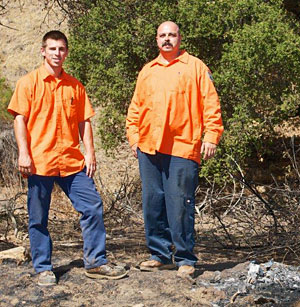
Lowell Johanknecht, left, and Enrique Ramos are the latest Public Works heroes. Photo/ Christian Garcia DPW
“If an accident happens and you’re around, you rise to the occasion. This job can be dangerous, too.”
That certainly was the case for the award’s first recipient, Marco Andonaegui, who was replacing traffic signs in 2004 on Topanga Canyon Boulevard near the 101
Freeway when he glanced up and saw a child tumble out of an SUV.
“He was 8 years old and his buckle must have come undone,” says Andonaegui, a 30-year DPW employee who says he still gets chills when he thinks of how close the child came to being hit by oncoming traffic.
“I was alone, going the opposite direction and they were just a couple a cars in front of me.”
Andonaegui scrambled out of his county vehicle, jumped the median and grabbed the child as the SUV drove on, the child’s mother oblivious to what had happened.
“Cars were swerving around us, braking around us, the little boy was crying and crying,” recalls Andonaegui. “I don’t know how the heck I didn’t get hit, let alone the little kid.”
Fifteen minutes later, he says, the mother circled back, frantic.
“She was desperate and grateful, and she must have given me 20 or 30 thank yous, but she was crying so hard, she forgot to ask for my name or give me hers,” he remembers.
It was only afterward, he says, that he learned she had written down the phone number on the back of his county truck and called the department. A father of grown children, he says he never heard from the woman again and still doesn’t know her name or her son’s name, but he still keeps his award plaque in his Lynwood living room.
Dam Operator Gary Elrod says he and his fellow crewmen on the remote San Gabriel Dam compound likewise never heard again from the young man they rescued.
It was early on a Tuesday morning, May 29, 2007, and the seven dam workers, several of whom live on the isolated site high in the San Gabriel Mountains, were starting their day early when Assistant Dam Operator Benny Velasco spotted a body in a drain near the roadside.
“It looked like he’d been attacked at another location, stuffed in the trunk of his car, driven to the entrance area of the San Gabriel Dam in Azusa Canyon and left there for dead,” recalls Elrod. “I personally counted nine stab wounds.”
A 25-year DPW employee who had worked in his youth with an emergency response team in Saudi Arabia, Elrod says he grabbed his blanket and safety gear and started to administer first aid.
As the crew waited for paramedics to arrive, Elrod tried to keep the barely coherent victim from falling into unconsciousness.
“This isn’t your time,” he remembers repeating to the young man as the sun rose over the mountains. In the hospital, Elrod says, the victim, who was from Whittier, refused to name his attacker, and the case was still unsolved three months later when he stopped asking about it.
“He denied everything he’d said to me when the sheriff questioned him later,” says Elrod. “All I know is, he’s out there somewhere with a horror story to tell his children and he’s lucky we came along when we did.”
The workers say they don’t mind that the recipients of their help often have no idea who they are or what department they work for.
“It makes you feel good just to be able to help,” says Johanknecht, the 23-year-old road laborer who pulled the woman from the burning truck last month on Mulholland Highway near Las Virgenes Road.
Johanknecht, who lives in Redondo Beach, says he had finished his shift at the Road Maintenance Division’s Yard 339 near Agoura Hills and was heading off to meet his girlfriend at their community college when he noticed the plume of smoke and the overturned Chevrolet Suburban. Pulling over on his motorcycle, he called 911 and ran toward the crash site.
“The 911 operator asked if anyone was in the car, and I said yeah, there’s a lady in the driver’s seat,” he remembers. “Right then, an older gentleman on a bicycle came up the hill and said, ‘What do you want to do?’ And I said, ‘Get her out!’”
Just then, he says, Ramos pulled over, having seen the skid marks, the smoke and his coworker’s abandoned Suzuki DR650. Working together, the three wrestled the woman, who appeared to be in her 40s, out of the black SUV and back toward the road’s shoulder.
“She was panicked and freaking out and pushing us away and in shock,” Johanknecht says, “and smoke was engulfing the car and all the air bags had deployed and blocked all the windows.”
As they carried the woman to safety, the SUV’s gas tank exploded, igniting a brushfire that engulfed nearly two acres before two Super Scoopers and four water-dropping helicopters were called in to contain it. Los Angeles County Fire Inspector Scott Miller could not release the woman’s name, but said she was transported to a local hospital. Ramos and Johanknecht say they never found out who she was and haven’t heard from her.
Johanknecht says his parents and girlfriend were “worried and proud at the same time” when they heard what happened, and wishes the crash victim—whoever she is—a speedy recovery.
“You never expect this, but you never know—we work out here in no man’s land, and a lot of things happen,” he says. “I just hope that someone would do me the same favor if something like that ever happens to me.”
Posted 10/15/13
The 405′s teachable moment
August 22, 2013
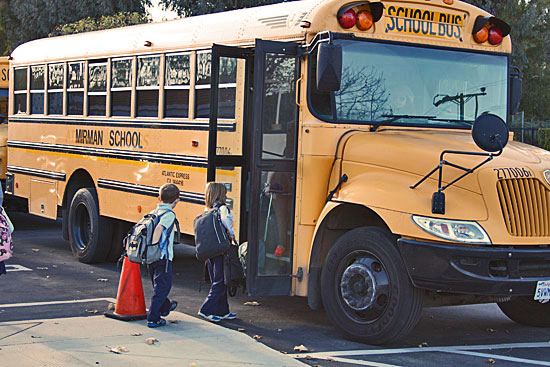
Nearly one-third of Mirman School students now ride the bus, along with pupils from nearby Berkeley Hall.
It’s that time of year again, when parents and kids run around making sure they’ve got all those back-to-school essentials: backpack, glue sticks, highlighter pens, detour map…
In the 405 Project zone, the start of the school year comes with an extra dose of uncertainty as extended ramp closures, lane reductions and other traffic headaches can make tardy slips seem as inevitable as pop quizzes.
This year, as the long-running project heads into the homestretch, two major, months-long ramp closures are adding to the already challenging traffic patterns that accompany the first weeks of school.
At 10 p.m. tonight (Thursday, August 22), the eastbound Wilshire on-ramp to the northbound 405 Freeway will be closing for 90 days. The work is needed to complete the ambitious flyover ramps portion of the project, which is expected to make it safer and easier to enter and exit the freeway at Wilshire Boulevard. When finished, the new, longer on-ramp will be able to accommodate nearly three times as many vehicles.
At the same time, the Sunset Boulevard off-ramp of the northbound 405 is also closed until November in order to create a longer, wider ramp that can hold 60% more vehicles. (Detour information for both closures is here.)
Meanwhile, the Mulholland Bridge over the 405, under construction after being dismantled in two Carmageddons, is still down to one open lane in each direction, slowing the commute to and from numerous private schools located on Mulholland Drive.
It all adds up to a rolling real-life lesson in planning, coping and improvising. And, as strange as it may seem, some of the solutions to emerge are now so popular that they’re likely to outlast the project.
Like the shared busing program developed to transport Mirman School and Berkeley Hall students through the Mulholland maelstrom that the construction unleashed.
“We never had a bus. It never seemed like it was warranted,” said Jocelyn Balaban, the Mirman administrator who developed the program. “The 405 construction pushed it.”
Now, more than 100 children, nearly one-third of the student body, are riding the school’s small fleet of buses, she said.
“The kids love the bus,” she said, and so do parents happy to dispense with the stress of fighting traffic every morning. “One father said to me, ‘I’m a better parent because of this.’ ”
Robert Woolley, a former Mirman administrator who served as the institutional coordinator for the Mulholland Educational Corridor Association when the 405 Project first rolled out, said the construction required radical readjustments to family routines.
“When Carmageddon first happened, gosh, the first couple of weeks it took people an hour or an hour and a half to get to school because of reduced capacity on the bridge,” said Woolley, now the director of development for USC’s Dornsife College. “A lot of parents waited till the last minute to drop off their kids. People learned, but there were a couple of weeks when it was really rough.”
It didn’t help that Carmageddon—the weekend-long freeway closure to pull down half of the Mulholland Bridge—had finished early and without the dire traffic impact many had predicted. Some parents, he said, “got lulled into a false sense of security and then the first day of school hit—BAM!”
After that, carpooling and busing really took off.
Those tactics also have proven popular at the Brentwood School off Sunset Boulevard, where they’re approaching the first day of school Tuesday with cautious optimism about traffic—despite the ramp closures.
“I think we’ve navigated the major closures to date pretty well,” said Shirley Blake, the schools’ director of communications.
The school’s other coping strategies include scheduling parent meetings and school events at non-peak traffic times and having faculty and staff arrive for work before 7:30 a.m. Students who drive themselves to school are required to travel in carpools and also arrive before 7:30 a.m. That policy predates the project but “it has certainly helped and I think it’s increased,” Blake said.
“We are just rolling with the punches,” she added.
Cori Solomon, president of the Brentwood Glen Association, is also used to rolling with the punches but she’s nervous about what the beginning of this school year will bring to her neighborhood. “Even though it’s old hat, I definitely have apprehension” about the simultaneous ramp closures, Solomon said. The Sunset ramp closure, which started August 3, “hasn’t been too bad—but school has been out.”
UCLA, which is “really the 800-pound gorilla,” starts Sept. 23.
By this time next year, the project—with its ramp and bridge improvements and new, 10-mile northbound carpool lane—is expected to be finished. With three back-to-school seasons under their belts, project officials are approaching the fourth with an array of mitigation measures.
A new, three-lane northbound on-ramp to the freeway from Santa Monica Boulevard reopened this week, just in time to serve as an alternative for motorists stymied by the Wilshire on-ramp closure.
Officials also are doubling the number of traffic control officers—from 12 to 24—at intersections in the area.
“Those will remain in place all next week as schools go back,” said Kasey Shuda, construction relations manager for the project. She said that officers will continue to be stationed at “prime locations” even after the back-to-school rush subsides.
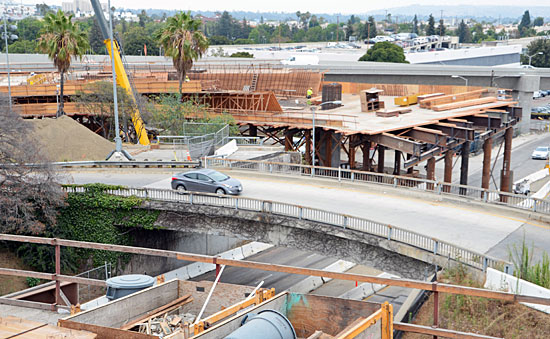
The current northbound on-ramp from eastbound Wilshire, shown at center, will be demolished. Photo/Metro
Posted 8/22/13
Night bridge work closes freeway
June 20, 2013
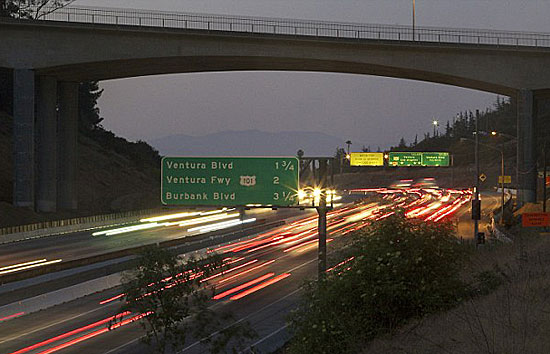
The Mulholland Bridge, above, and Skirball Bridge will close on upcoming nights, along with the northbound 405.
Work this week on two overpasses across the 405 Freeway is prompting night closures of both bridges and the freeway.
The Skirball Bridge is being closed nightly from 10 p.m. through 6 a.m. so that girders can be installed to form the bridge’s deck. That work continues tonight and Friday night, and is set to conclude by Saturday morning. Because of the size of the girders—the largest weighs 128,000 pounds—the northbound freeway running from Getty Center Drive to the 101 Freeway will be closed as well so that motorists aren’t endangered. Ramps in the area start closing tonight and Friday as early as 7 p.m., with lane closures beginning at 10 p.m. The entire northbound stretch will be closed from midnight each night, reopening at 5 a.m. the following day.
Also closing each night is the Mulholland Bridge, where advance work is taking place in preparation for pouring concrete to form the bridge’s deck. The bridge will be closed just before midnight tonight and Friday, reopening by 6 a.m. the next day. Details of the closures are here.
A community meeting is scheduled for tonight, Thursday, June 20, to look ahead at two long-running ramp closures being planned for the project. Plans currently call for the northbound Sunset Boulevard off-ramp from the 405 to close for 120 days starting August 3, and for the eastbound Wilshire onramp to the 405 to close for 90 days later in the month.
The meeting, running from 6 p.m. to 8 p.m., will be held in Room C of the Westwood Recreation Center, 1350 S. Sepulveda Boulevard.
The project, to construct a 10-mile northbound carpool lane on the 405 Freeway along with other improvements, has required the demolition and rebuilding of three bridges spanning the freeway. The Sunset Bridge already has reopened. The rebuilt Skirball and Mulholland bridges are slated to reopen by year’s end.
Posted 6/21/13
Mapping the end of the road on the 405
March 14, 2013
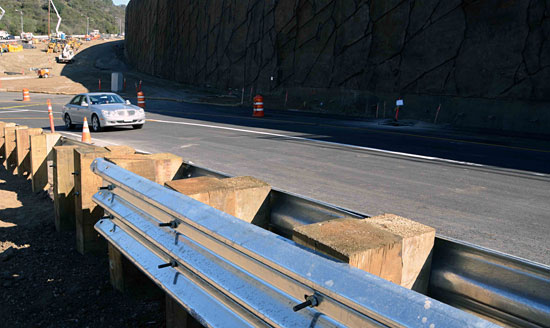
A key part of the project, a new Skirball Drive onramp to the southbound 405, opened earlier this month.
With the massive 405 Project now two-thirds complete, officials have unveiled a staggered endgame schedule which calls for major portions of the project to wrap up this year while work on one troublesome segment continues into 2014.
The delay involves the project’s middle segment—chiefly in the area around Montana Avenue and Church Lane—where utility relocations and the necessity of shifting Sepulveda Boulevard have proved vastly more time-consuming than expected.
Overall, unforeseen utility relocation issues have not only eaten up valuable time but also have driven up the cost of building the project, according to a briefing presented this week to Metro’s Construction Committee.
Engineering challenges involving a single 12-foot-by-12-foot box encasing a storm drain under Sepulveda Boulevard were particularly problematic, project manager Mike Barbour told the committee. In addition, 16 retaining walls needed to be torn down and rebuilt because they were deemed to be structurally unsound.
Metro officials say that even with the unanticipated obstacles, the project’s “design-build” construction process, in which engineering takes place as work moves along, has saved hundreds of millions of dollars and seven years of building time.
As it stands now, virtually all of the utilities have now been relocated, and the project is on track to finish work on most major elements by year’s end—including the Wilshire flyover ramps and all three bridges that have been demolished and are being rebuilt as part of the project.
The heart of the undertaking is construction of a 10-mile northbound carpool lane on the 405 Freeway from the 10 to the 101. When completed, it will form part of a 100-mile carpool lane through Los Angeles and Orange Counties, believed to be the nation’s longest such stretch.
In addition to building the carpool lane and demolishing and reconstructing the Sunset, Skirball and Mulholland bridges, workers have realigned 28 on- and off-ramps, widened more than a dozen underpasses and constructed some 18 miles of retaining and sound walls.
The southernmost segment of the project, running from the 10 Freeway to Wilshire Boulevard, is expected to open by mid-year, while the north stretch is on target to finish by year’s end, Barbour said.
The sheer size and complexity of the project has made things difficult for those who live in the area, Barbour acknowledged. But the end is in sight.
“They’re getting through it,” he said in a recent interview. “We’re as frustrated as they are. It’s been a long, torturous job.”
Posted 2/21/13
Coldwater Canyon’s pipe with a past
March 14, 2013
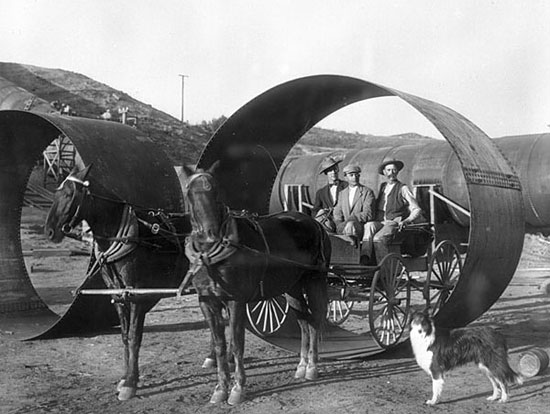
Undated DWP photo shows pipe used for aqueduct. Smaller pipe of the same riveted steel built the trunk line.
It was 1913 when William Mulholland famously declared, “There it is. Take it.”
But it wasn’t until 1915 that thirsty folks down in the city of Los Angeles could actually take a swig of all that Owens River water pouring into the Los Angeles Aqueduct.
The missing link? The City Trunk Line, known at the time as the “San Fernando Syphon,” an underground water pipe stretching from Sylmar across the Valley (not yet part Los Angeles) through a tunnel in the Santa Monica Mountains to the Franklin Reservoir above Beverly Hills.
With the trunk line’s completion on June 6, 1914, and connecting pipes finished the following year, Mulholland’s aqueduct at last had a direct connection to the city whose growth it would fuel so explosively in the decades to come.
Now, 99 years later, a new generation of Angelenos is feeling its power. And not in a good way.
Commuters on Coldwater Canyon Avenue, a major thoroughfare between the San Fernando Valley and the Westside, recently learned that the street will be closing between Mulholland Drive and Ventura Boulevard for nearly five weeks, from March 23-April 25, so that the city’s Department of Water and Power can replace a 1.3-mile segment of the aging pipe. [Updated 4/24/13: Coldwater Canyon has been reopened, two days ahead of schedule, city officials announced. However, restrictions on left-hand turns are still in place through June 1.)
Clearly, the inconvenience will be sizeable. As Supervisor Zev Yaroslavsky told reporters at a news conference this week announcing the closure: “You can put lipstick on a pig, but it’s still a pig. And this is a pig of a project.”
But he and other local leaders emphasized that the work is important—and unavoidable.
Corroded and susceptible to leaks, a section of the trunk line burst sensationally in 2009, sending millions of gallons of water bursting through the pavement and damaging homes and businesses around Coldwater Canyon and Ventura Boulevard. Earlier, in 2002, the line ruptured in Pacoima after workers inadvertently scraped the pipe, hastening corrosion on that segment to the breaking point.
The Coldwater Canyon closure comes after some 35-45% of the old pipe already has been replaced; modernizing the entire trunk line is expected to take about ten years, said Susan Rowghani, director of the DWP’s water engineering and technical services division.
About 25,000 gallons of water gush through the trunk line on the average each minute. With a diameter ranging from 62 inches to 72 inches in various places, the pipe is smaller than the massive pipes of the aqueduct itself, which range from 84 inches to 120 inches and were photographed at the time of construction with automobiles and even horse-drawn buggies parked comfortably inside. Other than size, though, the pipes used in the aqueduct and trunk line were virtually identical, made of the same riveted steel that was the construction standard at the time, said Fred Barker, manager of water transmission operations at the DWP and the agency’s unofficial historian.
Despite the trunk line’s ripe old age, he said, it’s far from unique in the city’s subterranean water world, where 287 miles of the DWP’s 7,289 miles of pipe date back to 1914 or before.
There’s even a cast iron pipe from the mid-1880s that still runs under 7th Street downtown for six to eight blocks, he said. There are no plans to replace it at the moment. “It’s performing very well,” Barker said. “There’s no need to replace a pipe that doesn’t leak.”
Sadly, the same can’t be said of the venerable City Trunk Line. So it’s with a sense of respect for history that Barker marks its inevitable passing from the scene.
“We talk about this event in 1913, when Mulholland and 40,000 people were out there and the water came down the hill and he said, ‘There it is. Take it.’ But the only way they could take it was in little souvenir bottles…if you wanted that water, you had to go out to Sylmar to get it.
“They had to get it to the city. This is the pipe that did it.”
Now the riveted steel pipe of a century ago is giving way to modern day welded steel—which, Barker said, “is going to last at least as long—and maybe twice as long.”
Posted 3/7/13
Getting schooled in the Pass
January 15, 2013
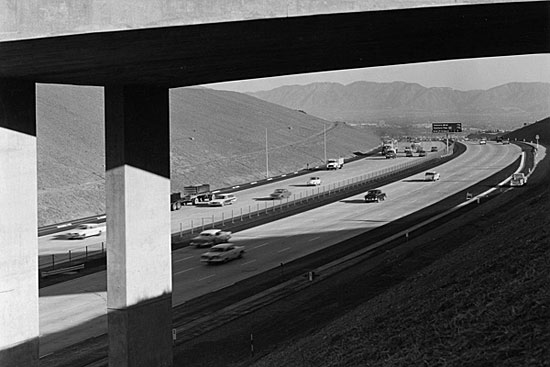
The 405 Freeway through the Sepulveda Pass, shortly after the Mulholland Bridge opened in 1960. Photo/Metro
Pop quiz, kids. Grab your No. 2 pencil and turn your attention to one of the 405 Freeway’s most fabled stretches. The Sepulveda Pass is:
a) A crucial thoroughfare between the Westside and the San Fernando Valley
b) Part of a long-running $1 billion-plus construction project
c) The hill L.A. commuters love to hate
You don’t have to be a drive-time traffic reporter to know that the answer is “all of the above.” But if all you know about the Sepulveda Pass is what you’ve seen through your car’s windshield, an upcoming course at the Skirball Cultural Center aims to unspool the mysteries—historic, geographic, and cultural—behind an essential piece of the Los Angeles landscape.
“The Sepulveda Pass: From Creation to Carmageddon” will be held on four Sunday afternoons beginning February 10. The instructor is Erik Greenberg, director of education at the Autry National Center, who aims to take students on a tour of the Pass from its geologic beginnings through centuries of human history, including its emergence as an important center of Jewish life in Los Angeles as home to institutions including the American Jewish University, Stephen S. Wise Temple and the Skirball.
“The Pass plays an important role in the lives of lots and lots of people,” said Greenberg, pointing out that the stretch has been called “L.A.’s Brooklyn Bridge—dividing people and uniting people.”
Adele Lander Burke, vice president of the Skirball’s “Learning for Life” adult education program, said it was high time to explore the Pass.
“I think it’s on people’s minds a lot,” she said. “We lived through two Carmageddons and did quite well…also, it’s on Sundays. There’s no construction going on during the weekend, so it’s very easy access.”
The four-session class costs $60 for Skirball members, $75 for non-members. Bragging rights for your next commuting gripe session: priceless.
Posted 1/15/12
Sunrise on Sunset
October 4, 2012
A wider, modernized Sunset Bridge is set to reopen for business on Monday, September 24, marking a major milestone in the progress of the 405 Project to bring a northbound carpool lane and other improvements to one of the nation’s most heavily-traveled freeways.
The rebuilt bridge will be 120 feet across—30 feet wider than its 1950s-era predecessor. In addition to two travel lanes in each direction, it also has new, dedicated turn lanes for motorists to access the freeway without affecting the flow of east-west traffic. Sidewalks and shoulders are wider, too, and the bridge has been upgraded to current seismic standards.
The bridge provides a major conduit across the Westside, with UCLA on one side and Brentwood on the other. Between 18,000 and 22,000 motorists cross it each weekday.
“It’s a lot wider and much safer,” said Mike Barbour, who is heading up the project for Metro. “It’ll be a lot more comfortable for people to get on and off the freeway.”
Monday’s reopening comes after more than two years of demolition and reconstruction work on the bridge. One final push is needed to complete the job, however, and the bridge will be closed from 10 p.m. to 6 a.m. on Friday, Saturday and Sunday nights. The bridge will be reduced to a single lane in each direction from 6 a.m. to 10 p.m. on Saturday and Sunday. Details are here.
The Sunset Bridge is the first of three overpasses to be demolished and rebuilt during the 405 Project. Demolition work on one of the others, the Mulholland Bridge, will take place on September 29 and 30 will require the weekend-long 405 Freeway closure known as Carmageddon II. Angelenos are being encouraged to “eat, shop and play locally” during the closure and to avoid driving in the area.
Posted 9/20/12




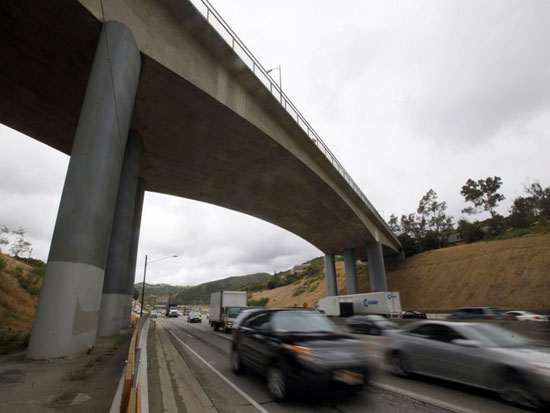
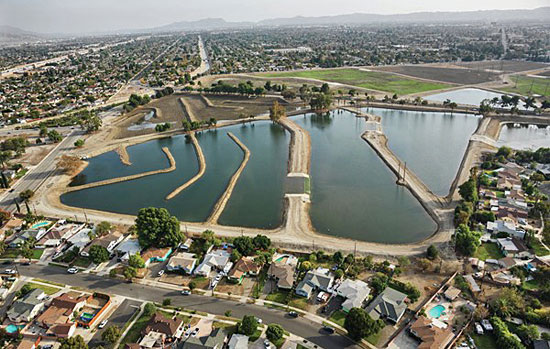
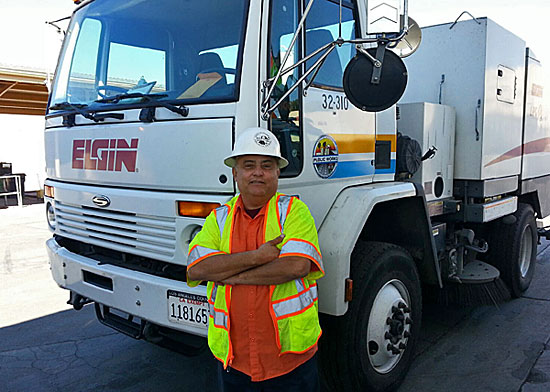
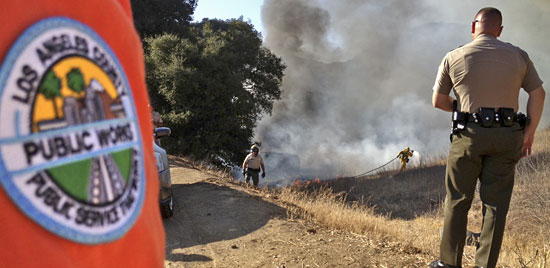
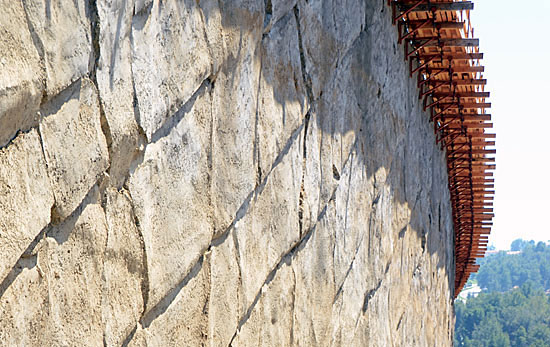
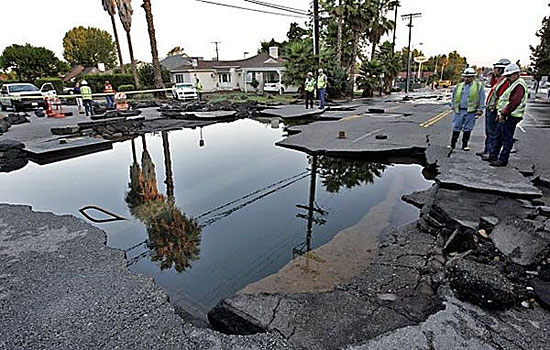
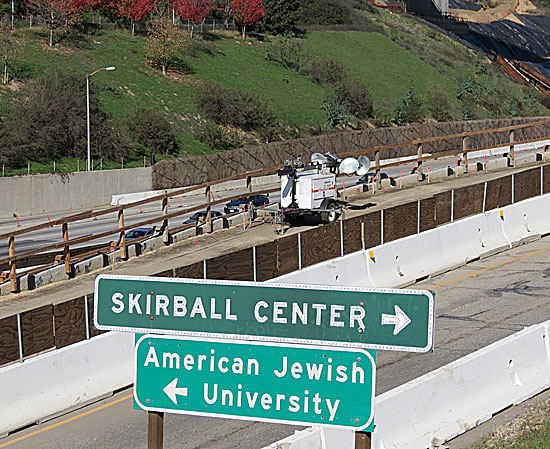
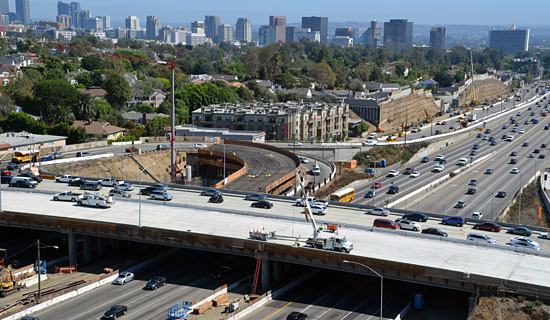







 405 bridge work causes a stink
405 bridge work causes a stink

